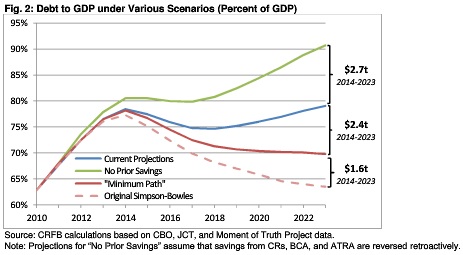Our Reaction to the State of the Union
Last night, President Obama delivered the first State of the Union address of his second term. The President's speech covered a wide range of issues, ranging from our current economic outlook, to immigration reform, to gun control, and more. But as expected, fiscal policy was featured prominently in the speech.
Encouragingly, the President was right on mark in his call for us to “finish the job” on deficit reduction. Too many commentators have suggested the United States has done enough deficit reduction and no longer needs to worry about the national debt. The President also deserves credit for talking about the importance of tackling entitlements. As he rightly remarked, “the biggest driver of our long-term debt is the rising cost of health care for an aging population. And those of us who care deeply about programs like Medicare must embrace the need for modest reforms -- otherwise, our retirement programs will crowd out the investments we need for our children, and jeopardize the promise of a secure retirement for future generations.”
And finally, the President rightly called for replacing the across-the-board spending cuts in sequestestration with a combination of tax and spending reforms.
At the same time, we are very concerned that President has set the target for deficit reduction far too low. Although the President argued that we only need $1.5 trillion of further deficit reduction to reach the $4 trillion many economists support, he failed to mention that the $4 trillion economists were calling for after the Simpson-Bowles report is now more like $6.7 trillion today. By that measure, our debt problems are far from solved.

Replacing the sequester with a thoughtful plan that tackles entitlement reform and tax reform is the right approach, and it is good to see the President calling for that. However, we do have some questions about the size and scope of deficit reduction that President Obama is proposing. Specifically, he stated that we only need $1.5 trillion more in deficit reduction over the next ten years.
As we showed in our recent paper, $2.4 trillion in additional deficit reduction is the minimum needed to put the debt on a clear downward path relative to the economy. Only enacting $1.5 trillion in additional savings carries with it several risks and debt would only be temporarily stabilized.
President Obama also claimed to be seeking the same amount of health care savings as the Simpson-Bowles plan proposed on Medicare at the beginning of the next decade. We've addressed a similar claim in the past and if last year's President's Budget is any indication, the White House will have to find roughly an additional $10 billion of savings per year to reach this goal. We hope to see more reforms to health care in his next budget.
Not all of the speech was related to the budget and the effects that many of the other proposals would have on the deficit is uncertain. But we hope that as he looks to tackle these other issues, whether it is immigration, climate change, or gun control policy, that he will do no harm to our debt and deficits -- and there in fact may be areas where deficit reduction is very attainable although not the primary objective (cap-and-trade and his higher education plans, for example). Many of the other areas allow for opportunities to boost economic growth or lessen the budget deficit, and we encourage the President and Congress to take advantage of these chances.
Overall, we do agree with many ideas that the President put forward last night. But the next steps will not be easy. As CRFB President Maya MacGuineas said in our press release, the President and Congress still have a ways to go before they can reach a comprehensive plan and compromises must be made by both sides:
Our leaders must aim for debt sustainability over the long-term and nothing less. With upcoming action forcing moments presented by the automatic sequester, funding for the federal government up for renewal, and the normal budget process this spring, elected leaders from both ends of Pennsylvania Avenue, both chambers of Congress, and both parties should be working toward a comprehensive debt solution.